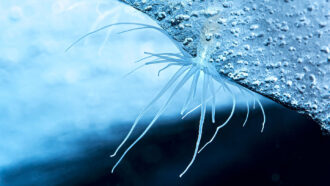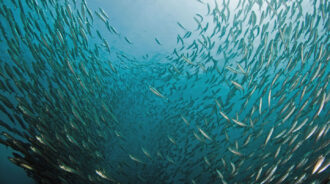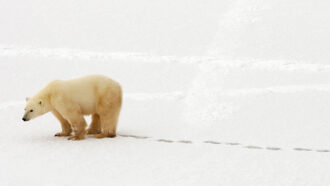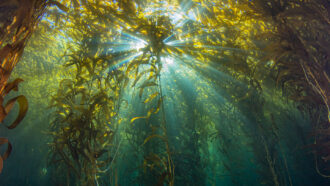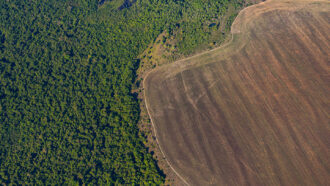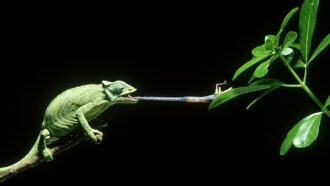Welcome to the Arctic’s all-night undersea party
The months-long, dead-of-winter darkness hides a surprisingly lively cast of characters, scientists find
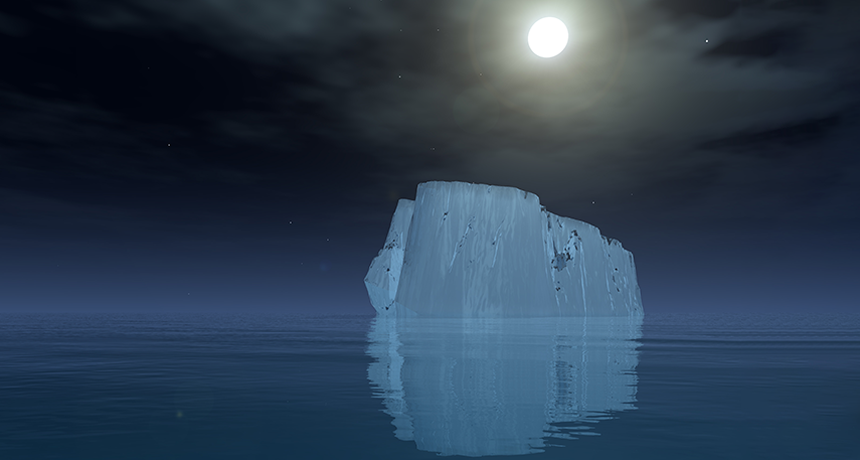
It’s dark during the Arctic winter. The sun doesn’t rise for days or even months. But scientists are learning that all is not quiet in the Arctic night (seen here in an illustration). There’s a months-long party happening under the sea.
bestdesigns/iStockPhoto
Louis Fortier had a problem. The seals would not leave.
Fortier is a marine biologist at Laval University in Quebec, Canada. It was the winter of 2007 to 2008 in the high Arctic and he was aboard a research ship — the CCGS Amundsen. Fortier was there trying to study what fish do under the Arctic ice during the long, dark winter.
As winter closed in, the sun disappeared. The sea began to freeze. The ship eventually sat locked in ice up to two meters (6.5 feet) thick. The scientists were all alone.
Except for the ring seals.
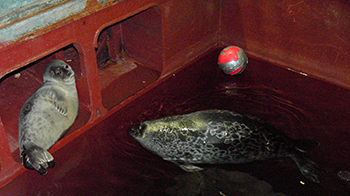
The Amundsen has a moon pool — a hole in the middle of the ship that opens into the water. The air temperature outside might be –40° Celsius (–40° Fahrenheit), but inside the ship, the moon hole is at room temperature, and the water is –2 °C (28 °F). In the high Arctic winter, that’s positively balmy.
Scientists use the moon pool as a convenient way to take measurements without having to cut through thick sea ice. To the ring seals, though, it was a sauna. “They turned it into a social club,” Fortier recalls. “There were up to nine or 10 ring seals at a time in the moon pool. They would sleep there, just floating and spending the day. They liked it. It was warm. They were protected from polar bears.”
Unfortunately, the seals made terrible lab assistants. They hogged the moon pool. They flitted past the researchers’ sensors. Worst of all, they feasted on the polar cod that Fortier was there to study.
Ring seals may be the most annoying (and adorable) of the Arctic’s winter inhabitants, but they’re hardly the only ones. To learn what happens during the bleak season, researchers have had to adapt to the darkness, much as have the creatures that live there. Scientists are learning that even while the Arctic is frozen and dark, it is far from quiet. But with people now moving into the Arctic and lighting up the night, they may cause changes that scientists never dreamed of.
Black sea
A winter night in the high Arctic is no joke. As fall turns to winter in the far north, the sun sets. It will not rise again until spring.
Day and night are the result of the Earth spinning on its axis — the line that runs through the north and south poles. People experience day when their side of the planet faces the sun, and night when it faces away.
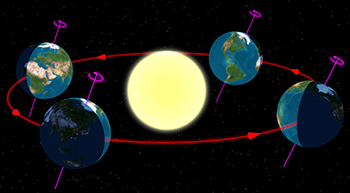
The axis around which Earth spins is tilted in relation to the plane on which our planet travels around the sun. This gives rise to our seasons. This tilt never changes. Instead, as the Earth takes its yearly trip around the sun, the North Pole will point slightly away from the sun during the winter, and toward the sun in summer. When the North pole is tilted away from the sun, days in the Northern Hemisphere get shorter and colder. That’s winter. Half a year later, that tilt will point toward the sun again. Now, the Northern Hemisphere experiences longer, warmer days — summer.
The distance north or south of the equator is described in degrees. The equator is at zero and the North Pole at 90°.The Arctic Circle is 66° north. North of that line, the sun doesn’t even peek above the horizon for at least part of the winter. This is the polar night.
Dawn won’t break again until the tip of Earth’s tilt again starts coming around toward the sun. The further north you go, the longer this takes. At 67° north, Kiruna, Sweden is just above the Arctic Circle. Its polar night lasts 28 days. In Svalbard, Norway, at 78° north, the night spans 84 straight days. At the North Pole itself, the sun doesn’t rise above the horizon for 179 days. That’s nearly six months!
Scientists used to think that this months-long night was silent, dark and basically dead, notes Jørgen Berge. This marine biologist works at the University of Tromsø in Norway. There, he studies life in the ocean.
“We have an expression in Norwegian,” Berge says: When fishermen can’t catch any fish, it’s because there’s a “black sea” or “dark sea.” The term “refers to a dark place where there is no biological activity,” he explains. “It’s a good description of how we used to think of the polar night.”
But not anymore.
Tiny lives in the night
Light feeds life. Without sunlight, plants can’t perform photosynthesis — producing energy from sunlight and water. The plants’ primary production forms the base of most ecosystems. Plants grow and provide food for animals, which provide food for other animals. And so on. To scientists, then, darkness seems like a deal killer.
“The period with light is the time when most of the primary production is happening,” says Anna Båtnes. She’s a marine biologist at the Norwegian University of Science and Technology in Trondheim. “Plant growth, algae, the whole system is based on this production.” So scientists assumed that without daylight, life slowed and nearly stopped.
But Berge, Båtnes and their colleagues have found tiny creatures called plankton swirling in the dark ocean. Phytoplankton (FY-toh-plank-ton) — tiny ocean organisms that make food from the sun — aren’t active. But zooplankton (ZOH-plank-ton) — tiny animals that eat other plankton — don’t let the dark get them down.
When there is a regular day/night cycle over a period of 24 hours, hordes of tiny zooplankton called copepods (KOH-puh-podz) use the sun to time their exercise regimen. These tiny crustaceans cycle up and down in the water in a pattern called diel (Di-EEL) vertical migration. By day, the tiny critters descend into deep water. At night, they ascend back to the surface.
These daily laps are a matter of survival for the zooplankton. But this also makes them a dependable source of food that is “really attractive to predators,” Båtnes notes. “They’re full of fat,” she explains — “like energy bars.” In deep waters during the day, she notes, copepods are harder for predators to see. At night, it’s safer for the floating energy bars to surface and feed on the phytoplankton there.
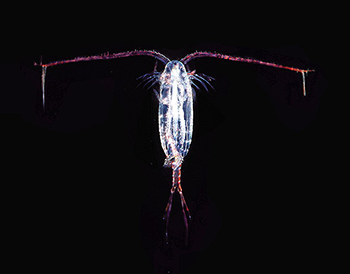
When there’s no sunlight — like during the Arctic night — it might seem like the copepods should sink and lay low. There’s nothing to eat, so it makes sense for plankton to avoid predators. But Arctic darkness doesn’t pause these animals.
Berge’s first clue? Plankton poo. He and his colleagues put out a trap to capture particles at the water’s surface during the polar night. When they pulled the trap in, they found plenty of plankton feces. And where there’s plankton poop, Berge notes, there must be plankton. This meant the copepods were still cycling up and down in the water, even when the sun was nowhere to be seen.
In fact, the polar night isn’t pitch black. “To the human eye, it’s dark,” Berge says. But the more time you spend in the dark, the more you notice what light there is. The moon is still there, giving off a faint glow. Some tiny creatures make their own light, called bioluminescence. And there are the Northern Lights — faint atmospheric light displays that occur when particles from the sun collide with gas in Earth’s atmosphere.
The plankton didn’t need the sun, Berge realized. When the sun left, the tiny critters timed their movements to the rising and setting of the moon. Berge and his colleagues published their findings in the journal Current Biology in 2016.
The moon doesn’t provide much light. But in the Arctic, even that little is enough. Båtnes and Berge showed. Copepods, they found a few years back, are so sensitive to light that they can sense the glow of the Northern Lights — even from 120 meters (390 feet) below the surface.
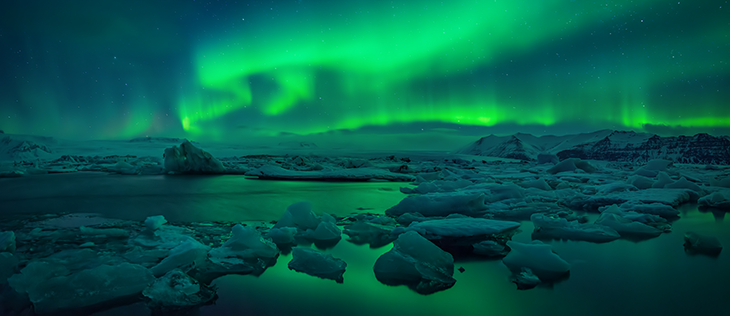
Nighttime cod clues
Copepods need to keep swimming or they’ll end up some fish’s snack. And they’re a favorite of the polar cod that Fortier was tracking through that dark winter of 2007 and 2008.
These cod are important because few other fish species roam the Arctic seas, Fortier notes. In a tropical site like the Red Sea, which separates Africa and Asia, “only two out of 10 [fish] will be the same species. But in the Arctic, 99 percent will be [polar] cod,” he explains. “It’s a pivotal species in the food web. They eat these small crustaceans and in turn are eaten by predators: marine mammals and sea birds.”
In summer, shallow areas of the seas north of Alaska and Canada teem with the fish. In the winter, though, the waters went quiet. Or they seemed to. Where were all the fish and what were they doing? Fortier’s team wanted to know.
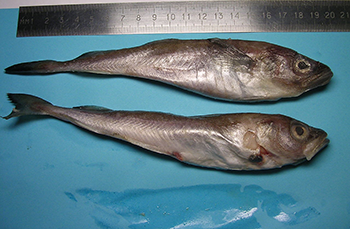
As it turns out, the fish weren’t gone. They were just moving deep. Fortier’s team spotted them hanging out at depths of between 200 and 400 meters (650 to 1,300 feet). “We thought they were just, you know, wasting time, just waiting for the sun and the food to come back,” Fortier says. Between battles with the seals, he and his team sank electronic sensors and nets under the ice.
They learned that the polar cod don’t have time to waste. “They’re very active in the winter,” Fortier says. “They keep feeding, and they lay their eggs at depth.” Those eggs will slowly rise, reaching the underside of the surface ice. There they’ll hatch between January and July.
The cod, though, had to avoid those pesky seals. With big livers full of tasty fats, the fish are a popular treat for the seals. So Fortier and his team began tracking seal dives, too. To avoid becoming seal snacks, those cod separate by depth based on their size.
When there is daylight, smaller fish hang out at depths of 160 to 230 meters (525 to 755 feet). But when all goes dark, the small fish rise up to between 90 and 150 meters (295 to 490 feet) below the surface. They rise up, high enough to be close to the surface. Shallow diving hungry young seals will swim right below them.
Bigger cod, however, always hang out deeper than 180 meters (590 feet). That lets them avoid even deep-diving grown seals, Fortier says. Bigger cod “don’t migrate because they are guaranteed to be whacked out by a seal.”
Whales go bump in the night
Fortier isn’t the only researcher plagued by seals. Kit Kovacs’ problem, though, is the bearded seal — another common Arctic native.
Kovacs studies marine mammals at the Norwegian Polar Institute in Tromsø. She has studied seals, but now is interested in whales. And bearded seals are trouble when you want to study whales, Kovacs says. “They cover up whale sounds.”
Kovacs is part of a group that tries to listen in on serenading bowheads. They are the only baleen (filter-feeding) whales that live full time in the Arctic. They make their livings gulping huge volumes of water, then filtering out the tasty plankton living in that water.
That means the whales need to follow plankton around, Kovacs notes. “Mammals that feed in the water column will follow their prey. If their prey goes deeper in the dark period,” she says, the whales will, too.
But it’s been hard to know where the whales went and what they did during the winter. “We don’t know much [about them], because they breed in the polar night in ice-covered water,” Kovacs says.
To track these giant, secretive mammals, Kovacs listens. Bowhead whales sing — a lot. Especially the males. “Singing is a combination of pickup lines and advertising,” Kovacs says. By dropping special microphones into the Arctic waters, her team could listen for these whale flirtations.
When they listened to the recordings, the scientists got a surprise. They tracked 184 different song types over three years. That means bowhead whales sing more types of tunes than do many songbirds. And each bowhead tends to sing just one song for months at a time. So 184 songs may mean there are more bowhead whales out there than scientists had assumed, Kovacs says — “unless they are changing their voices.”
The serenades were especially lusty in December and January. “What shocked us,” she says, was that they were singing “where it was 100-percent ice cover for most of those months.” With all that sea ice, there aren’t many spots for a whale to come up and catch a breath. But the whales didn’t care. It was time for romance. Kovacs and her colleagues published their findings April 4, 2018 in Biology Letters.
I saw a ship come sailing in
Bowhead whales are endangered in some places. That includes sites around Svalbard, Norway, where Kovacs studies these cetaceans. “People hunted them almost to extinction,” she says. They’re “one of the biggest whales in the Arctic — huge whales [with] tasty meat.”
Now the animals are protected against hunting. But the darkness that makes for a great whale date night is under threat. People are moving north and bringing sound and light with them.
An even bigger threat is climate change. As the world warms, the frigid Arctic isn’t quite as chilly anymore. Sea ice covers the area for less of each year. “The [sea ice] retreat in the spring is occurring earlier, and freeze-up is happening later in almost every region,” explains Donna Hauser. A marine ecologist at the University of Alaska in Fairbanks, she studies the ocean environment. If ice keeps melting at the current rate, scientists predict that within a few decades even the North Pole may not be ice-locked throughout the winter.
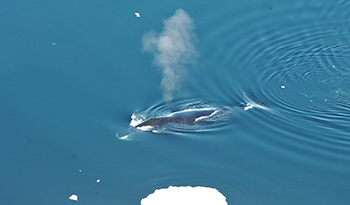
There is already open water for more of the year now. And open water is more likely to bring people and ships into contact with the creatures living there. Hauser and her colleagues looked at where ships travel when the ice is gone, and which animals live near those shipping lanes. They wanted to predict which species might suffer the most if shipping increased.
Land-based animals, such as polar bears, wouldn’t be too bothered by lots of shipping, Hauser and her colleagues found. But whales such as bowheads and narwhals likely would. “They’re species that rely on sound,” Hauser explains. The sounds of ships could disturb how the animals communicate. Or those ships could hit the whales and hurt or kill them. Hauser and her colleagues published their predictions last July 2 in the Proceedings of the National Academy of Sciences.
Ships are mainly a problem during summer and fall, when the Arctic gets plenty of sun. But other types of changes may linger.
Less ice may mean more tourists and other visitors, Kovacs says. When people move in to a new space, they tend to stay. And their lights stay with them.
Lighting the night
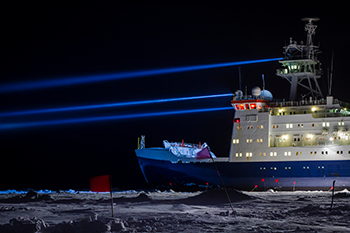
To sensitive creatures like Berge’s plankton, even a little extra light makes a huge difference. In fact, scientists may have overlooked a lot of life in the Arctic — because they were looking with light.
Berge and his team released a small, remotely operated vehicle, or ROV, from their research vessel to track plankton. When the ROV was far from the main ship, it picked up faint sounds, which it sent back to the scientists on the main vessel. In those sounds, the scientists detected huge quantities of plankton migrating up and down through the water. There were far, far more than Berge had ever expected. But as the vehicle came back toward the brightly lit ship, the plankton disappeared.
Were they fleeing the ship’s light?
To test this, Berge had the research vessel shut off all its lights. (“The captain was not pleased that we had to turn all the lights off when we had to take a sample,” he says.) Sure enough, sensors on the vessel now picked up rising and falling hordes of plankton. But those plankton darted away as soon as the lights came back on.
These results show that even the lights of science might be disturbing the delicate activity cycle of the Arctic night. Berge and his group published their findings January 10, 2018, in Science Advances.
Maybe we should think twice before we light the Arctic night, Berge says. “The polar night is an important part of the life cycle of many organisms,” he points out. “It’s not just a transition period between autumn and spring.”
Scientists may want to learn more about the Arctic night, and people may want to visit. But organisms that inhabit the Arctic night might just prefer we leave them in the dark.

